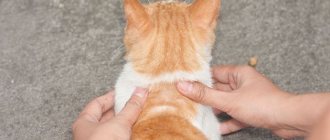Is it possible to take a cat on board an airplane?
Some airlines allow you to bring pets into the cabin, others do not. Therefore, it is necessary to find out the rules of the selected carrier in advance. Cats can only be transported inside the cabin if accompanied by a legally capable adult, in a special carrier or container. There can be no more than two cats in the container at the same time, the total weight of which must be 8 kilograms. Therefore, it is unlikely that you will be able to take two adult cats with you, but two kittens or a cat with a kitten is quite possible.
Rules for transporting cats on planes and in luggage
During the flight, there can be from 2 to 5 animals in the cabin, it all depends on the requirements of the air carrier. Therefore, you should inform yourself about your desire to take your pet on board in advance, when booking your ticket. In addition, cats can only be transported on a passenger plane if there are no dogs on board.
It is prohibited to place a container with an animal on an empty passenger seat. You can hold it on your lap or place it on the floor under the chair in front of you. It is also prohibited to place the container in places that impede access to the emergency exit.
During the flight, you should not let your cat out of the container, since it is impossible to predict its behavior in a stressful situation.
Some air carriers allow animals to be transported on planes exclusively in the luggage compartment. It is worth taking care that the cat does not freeze: put warm bedding on the bottom of the carrier, and dress your pet in a suit. The container itself can be placed in a fabric bag that allows air to pass through so that the pet is less worried.
Veterinary regulations of the country
Is it possible to spay a cat during heat?
When considering how to transport a cat on a plane abroad, it is important to find out what rules apply in the country you are visiting. Features of some states:
- visiting Australia for cats from Russia is only possible if the animal is transported through an accredited country. But even in this case, upon arrival, the pet will be quarantined for 10 days;
- England. Transportation is permitted only in the luggage box. The owner must have a document confirming that he does not intend to sell the pet;
- Israel. A visit is possible only if the pet has had a blood test for antibodies;
- Thailand. The country's quarantine service must be notified 15 days in advance that an arrival is planned. The owner independently writes an e-mail, in which he indicates the flight information, cat breed, address, and his contact information. You need to attach scanned copies of your passport and cat documents. The quarantine service will also respond by email. The received permit must be printed and presented at customs;
- Türkiye. You can bring a cat into this country only in a licensed container with reliable fastenings. The animal must be clean and healthy, the dimensions of the container are no more than 115 cm in the sum of three dimensions (length + width + height). The maximum weight of the pet and carrier is up to 9 kg. If the owner has visited the carrier’s website and cannot translate what is written there, it is worth contacting a native speaker.
Each state has its own laws, and they must be followed.
What is important to know when booking?
When booking a ticket, be sure to inquire about the rules for transporting animals of the selected airline, since they differ for all carriers. What you definitely need to find out:
- are there any restrictions regarding the transportation of animals;
- what documents are required to transport cats;
- find out where the cat will be during the flight;
- what are the requirements for carrying;
- transportation cost.
In addition, be sure to find out how many animals are allowed on board the plane and obtain permission from the airline to transport a cat. If you are traveling in the luggage compartment, you can obtain permission after purchasing your ticket. In the case of a cabin flight, permission must be obtained before purchasing a ticket.
If you are planning an international flight, it is important to find out the rules for importing animals by the country to which the passenger is flying. Some countries prohibit the import of animals into their territory or provide for quarantine, which can last from 3 days to six months.
Having found out all the nuances in advance, it is important to notify the airline employee at least 36 hours before the flight of your desire to fly with a cat.
How to avoid stress
To ensure that transporting cats or dogs on an airplane does not harm the animal’s nervous system, it is recommended to begin accustoming it to being carried long before the date of the intended flight. This will allow you to avoid stress when placed in a closed box for a long time and easily endure the flight.
From passenger reviews: “When I fly on a plane with my cat, I am calm, because she is accustomed to being carried and will not be scared when placed in a container.”
You should consult your veterinarian about how to transport a cat or dog with the least possible consequences for the pet’s nervous system. Typically, veterinarians do not recommend giving pets sedatives and tranquilizers, as this can negatively affect the pet's health. If the doctor allows it, the dog can be given a sedative tablet for animals before the flight. If there is a short flight ahead, it is better not to feed the animal. It is recommended to feed your pet before departure if the flight will last more than eight hours.
The family pet needs to be trained to be carried before the flight.
Before the flight, if you plan to transport dogs on the plane, you must undergo veterinary control at the airport, so it is recommended to arrive 3-4 hours before departure time.
Documents for transporting a cat in Russia
The rules for transporting cats on an airplane across Russian territory require the following documents:
- The cat must have a veterinary passport with records of all necessary vaccinations.
- A veterinary health certificate is required (form No. 1).
- Some airlines require a microchipping certificate.
Help about chipping
The certificate is issued at any veterinary clinic 5 days before the flight and is the cat’s main document.
After checking the documents, the carrier stamps the certificate and issues a boarding pass to the accompanying person.
Conditions and documents for transporting animals
The possibility of transporting animals is determined by several factors:
- breed and species;
- pet size;
- selected airline;
- countries of departure and arrival;
- place of transportation (cabin or luggage);
- Availability of pet documents and necessary vaccinations.
Important! Before booking a seat and purchasing an air ticket, you should call the company (at least two days before the scheduled departure date) and inform them of your intention to transport your pet. Only 5 animals are allowed on the aircraft. If all seats are booked, you will need to take an alternative flight.
Carrying on the plane is prohibited:
- aquarium fish;
- dogs of brachycephalic breeds;
Brachycephalic dog breeds
- any species of fish and animals that can only be found in water;
- rodents;
- arthropods;
- large animals – more than 50 kg (including container);
- sick pets;
- reptiles;
- wild animals and birds.
Not all companies allow the transportation of exotic animals, so it is important to check this information with the carrier in advance.
Transportation within Russia
In 2021, the requirements for documents for animals on domestic flights have been significantly simplified. Now only one international passport is enough, which contains the necessary information: vaccinations, treatments against parasites, name and more.
An example of an international veterinary passport
A certificate from a veterinary clinic is not required. It will only be needed if the pet is sent to an exhibition, for the purpose of entrepreneurial activity, or in a situation where the owner of the animal changes.
A veterinary certificate will be required for the exhibition.
At airports, people most often pay attention to the availability of vaccinations against rabies and viruses. But all this data is in the animal’s passport. The duration of the rabies vaccination is determined by certain conditions: no more than 1 year and less than 30 days.
International shipping
Before you buy a ticket for an international flight, you should visit the embassy of the country where you are flying to and find out the conditions for transporting pets.
For example, before traveling to the UK or Iceland, the pet must be in quarantine for at least six months. To fly to Tunisia, you must be vaccinated against Carré disease. Australia generally has very strict controls on the import of any animals.
Some EU countries (for example, Denmark, Sweden) do not allow the import of fighting breed dogs. Kittens and puppies under the age of 4 months cannot be imported into all EU countries.
Documents required include a veterinary passport of international format. It can be obtained at one of the checkpoints by first providing a state-issued veterinary certificate. There is a so-called replacement of documents.
Veterinary certificate form
An international passport is valid for 90 days, but it must be taken into account that it must remain valid for the duration of departure from a foreign country. The animal is also required to be microchipped.
By scanning the microchip, you can easily find out information about the pet owner. The microchipping procedure involves inserting a capsule with a chip under the animal's skin.
Animal microchip scanning procedure
Documents for taking a cat abroad
Crossing the border with a cat is an extremely troublesome task, bringing considerable stress to both the owner and the animal. Many countries are not loyal to the import of pets, even if they behave absolutely calmly, fearing dangerous diseases and parasites.
In addition to the documents required for domestic flights, you also need to complete the following:
- international veterinary certificate (passport);
- a certificate indicating breeding value or lack thereof;
- a certificate indicating that the animal is microchipped (required here).
When booking air tickets, you need to find out from the carrier additional details regarding receiving a cat at the end of the flight.
Cost of transporting a cat on an airplane
The service for transporting animals is paid, regardless of how the cat will travel - in the cabin with the owner or in the luggage compartment with suitcases.
How much it costs to fly a cat depends on the following factors:
- dimensions and weight of the container with the animal;
- flight range and duration;
- airline fares.
Payment for the cat's flight is made at the airport before the flight according to the excess baggage allowance. In this case, the cost is calculated as for a first class flight, even if the animal flies in the luggage compartment.
All airlines have their own tariffs for transporting animals. On average, for a cat weighing about 4 kg, you will have to pay from 50 to 100 euros for a flight from Moscow to Kyiv. However, some companies do not take into account the flight distance; the price is calculated solely on the weight of the animal.
Preparation of documents
Transporting animals on Aeroflot aircraft
To be able to transport a cat or dog on an airliner, you must first ensure that you have veterinary documents and certificates. Which documents are required depends on where the flight is being made, within the country or outside its borders.
The animal must be vaccinated according to age. You must also provide a certificate stating that you have been vaccinated against rabies. Since immunity from this disease does not develop immediately, vaccination should be done no earlier than 30 days before the flight date.
Before flying, be sure to visit a veterinarian
The animal must be sanitized from various parasites: ticks, fleas, worms. These activities must be completed 30 days before the flight.
The animal must have a chip installed. However, many passengers note that animals were transported across the Russian Federation without a chip. You must check at the check-in counter if you need a chip for domestic flights.
Thus, the flight of an animal is possible if you have the following documents:
- a completed international veterinary passport;
- document confirming microchipping;
- international type certificate;
- document confirming pedigree.
A certificate confirming the pedigree and breeding value of a pet, as well as an international certificate, are required only when flying abroad. If a rare animal is being exported, you may need a document permitting the animal to be transported abroad.
Certificate No. 1 is issued on the basis of a correctly completed veterinary passport in the service that carries out veterinary control. To obtain such a certificate, you may need to take the animal with you for examination.
Pet passport
The international veterinary passport must contain information about all vaccinations, including rabies vaccination. A stamp is placed in the passport confirming that the animal is healthy. All information must be accompanied by seals from the veterinary clinic where the animal is observed.
Important! Policies for transporting dogs and other animals on planes often vary from airline to airline. When issuing travel documents, it is recommended to further clarify all the nuances.
Carrying requirements
The carrier does not provide carriers for transporting cats on the plane, so the owner must take care of this himself. In the cabin of an airplane, a cat can be transported either in a durable bag with a hard bottom or in a shipping container. The bottom must be covered with absorbent material (this can be an absorbent diaper) that does not allow moisture to pass through, and the container itself must have dimensions of no more than 45x35x25 cm.
If the flight is planned in the luggage compartment, then transportation of the cat is allowed only in the container. In this case, the size of the container should allow the animal to straighten up to its full height and rotate freely around its axis.
The doors of the container must close tightly so that a nervous animal cannot accidentally open them. Sometimes airport staff ask you to remove the animal from the container for inspection. To make this easier, it is advisable for the container to have a removable top.
The cat carrier should be well ventilated and not have sharp corners so that the cat feels comfortable and does not accidentally get injured. There should also be a side around the perimeter of the bottom and a compartment for water and food.
Requirements for cages for air transportation
The choice of carrier must be approached very responsibly. If during domestic flights the requirements for containers are not too stringent, then international transportation requires a special container that meets IATA standards - without it, the animal may not be taken on board.
Have you ever transported a cat on an airplane?
Not really
Is it possible to transport a cat unaccompanied?
The unaccompanied cat transportation service is provided by many airlines. The animal travels on a passenger plane unaccompanied in a specially equipped heated compartment to avoid injury or hypothermia.
What documents are needed to transport an unaccompanied cat:
- a copy of the sender's ID;
- original veterinary passport of the animal, with notes on required vaccinations;
- veterinary certificate of the cat.
The cost of such a flight is paid at a double rate; the dimensions and weight of the container along with the animal are taken into account.
How to prepare a cat for flight?
To transport your pet cat on an airplane with minimal stress, it is recommended that you start preparing it for travel a few days in advance. To do this, he should be introduced in advance to the container in which he will be transported.
Veterinarians do not recommend giving your animal any sedatives. Indeed, during takeoff and landing, due to pressure changes in the atmosphere, the animal’s heart muscle experiences additional stress, and the presence of sleeping pills in the blood aggravates its condition.
To make the cat feel calmer, it is recommended to put something taken from home into the container: a favorite toy or the bedding on which he slept. Feeling familiar smells, he will be less nervous.
However, some animals experience enormous stress during travel, and without sedatives the cat will have a hard time. She will meow and rush around the carrier throughout the flight, causing inconvenience to the flying passengers. You should definitely consult with your veterinarian to choose the safest remedy to help reduce anxiety and restlessness in your animal.
Worming and rabies vaccination
In order to freely transport a cat or kitten by plane, the animal must be vaccinated against rabies and dewormed. These requirements are common to all air carriers, and without their fulfillment, a cat will not be allowed on board a passenger airliner.
Before being vaccinated against rabies, the cat is given anthelmintic drugs, so this stage cannot be avoided. Two weeks after deworming, the animal can be vaccinated against rabies.
In order for the airline to approve the flight, the vaccination must be at least 30 days old. It follows from this that you need to start preparing your cat for the flight no later than 1.5 months before the planned departure date. Kittens can be vaccinated no earlier than two months, therefore younger individuals cannot be transported. However, some carriers allow unvaccinated kittens to fly in the same cage with a vaccinated mother.
Should I feed and water my cat before the plane and during the flight?
The day before the departure of the flight, it is recommended to reduce the daily diet by half, and 5-6 hours before completely limiting the animal’s food intake, giving only water. This is done to prevent the cat from going to the toilet in the container, since the smell of feces will cause dissatisfaction among passengers. Animals, like people, can get motion sickness during a flight, and a full stomach can provoke vomiting.
After the plane takes off, you can treat your pet with dry cat treats to distract his attention from the surrounding reality and help him relax. If the flight is long, you need to take with you dry food, which the cat usually eats, and give it to your pet in small portions. In addition, wet food is not allowed in hand luggage, according to the airline's rules.
Often, transporting restless cats on an airplane can cause their body temperature to rise, so there must be drinking water in the carrier or a special drinking bottle for the accompanying person.
Preparing your pet for flight
Transporting a cat on an airplane requires mandatory preliminary preparation of the pet. 4 hours before departure you should not give him food, but you can give him water. A container of water is placed in the container; it is allowed to put some entertainment for the pet there.
Important! You should not give sedatives without a veterinarian's prescription.
It is important to accustom your cat to a carrier bag in advance to save him from unnecessary stress. Some inexperienced owners force cats into a container, which is why the animal becomes afraid almost immediately. It is important that the pet perceives everything that happens as a game, which is why they introduce the bag at home, leaving it open and giving the cat the opportunity to examine it. After this, you can take the animal outside in the same container to make sure it is safe. Only after such preparation can you choose an airline and book a ticket.
It is recommended to have with you:
- garbage bags;
- wet wipes;
- water and dry food to feed and drink your pet upon arrival;
- disposable diapers;
- disinfectant to get rid of unpleasant odors.
Note! Some carriers refuse to transport kittens under 4 months of age, that is, the age when animals can receive the necessary vaccinations. To avoid troubles, this point must be clarified before booking a ticket.
Preliminary preparation for the flight will help get rid of troubles on the plane
Receiving cats after a flight
Usually there are no problems getting your pet. Airlines that allow the carriage of cats issue animals separately from other baggage, at a special counter. If there is no such counter at the airport, then containers with animals are sent to the general baggage belt, but not mixed with suitcases, but placed in front of them.
If at the end of the flight you plan to transfer to another plane, you need to ask the airport staff to give you a carrier with your cat, otherwise he will be with your luggage the entire time.
An airport employee must check the documents for transporting the cat and inspect the animal. This procedure is paid and will cost approximately 30 euros.
What you need to transport a cat by train
Transporting a cat on a train is not the easiest test for its owners. It is unknown how the animal will behave during the trip, and the process may be complicated by the requirements of the railway company. To avoid unpleasant situations, there are a number of solutions that will help make this comfortable for both humans and cats.
Interesting article: all about the Abyssinian cat breed.
Which car is suitable: passenger or baggage
The only passenger carrier in our country is Russian Railways. If such a move is planned, it is better to find out in advance the existing rules of this state company in the field of transporting animals.
If you are using a shared carriage where the passenger is seated, you will need to pay extra for the cat and present a transportation ticket (receipt). There are other types of wagons that have different requirements.
Some trains provide only 1-2 seat compartments for transporting animals. This is a question worth asking when purchasing a ticket. Most often, you can only travel with an animal in a compartment carriage. This is dictated so as not to create inconvenience to other passengers. The main conditions for transporting animals by Russian Railways trains are listed in the table below:
Table of conditions for transporting animals in Russian Railways cars.
Cost of transporting cats on a train
Transporting a cat on a train has its own cost, which depends on the route, carriage, type of train and other factors. An additional fee is charged in reserved seat, seated and shared carriages. If the passenger travels in a compartment, no additional payment is required. The pet carrier is located in the place purchased by the owner.
If we are talking about high-speed trains, you will also have to pay extra. The “swallow” charges a fixed fee of 150 rubles. In Sapsan it is already included in the ticket price.
Transportation on long-distance trains
When transporting an animal, the owner must ensure sanitary and hygienic requirements, as well as the safety of other passengers.
Long-distance travel is considered to be a route longer than 700 km. The cost of transporting a cat will depend on the distance, for example, for a distance of more than 12,000 km the cost will be 3,000 rubles. To ensure your pet’s comfort, you must fulfill a number of requirements:
- ensure constant access to water;
- carry anti-motion sickness pills;
- If possible, at stations with a large parking lot, take the container with the animal into the fresh air and give her the opportunity to go to the toilet.
Also, when moving long distances, it is worth considering the cat’s diet. It is optimal to choose dry ready-made food. You should not feed your pet too often.
Transporting cats unaccompanied
The Russian Railways company offers transportation of pets without human accompaniment. This happens in the luggage compartment. The owner must write a corresponding statement at the box office and comply with a number of requirements:
- cage or special carrier;
- veterinary documents;
- food, water, hygiene products for the cat.
The cost of such a service is determined by the distance. During the entire journey, the animal will be under the supervision of train staff.
How does a cat cope with flying?
Approximately 7–12% of cats survive the flight completely asymptomatically and feel well upon arrival. In most cases, the cat still gets stressed, which is manifested by apathy and lethargy, refusal to eat, frequent urination, and reluctance to make contact with the owner. In 90% of cases, all symptoms disappear without a trace after 2–5 days, and the cat finds peace of mind.
If your cat is overly emotional, she may become very frightened during the flight, especially if she has to travel in the luggage compartment. Therefore, you should take this step only as a last resort. The consequences of the stress suffered will forever leave an imprint on the animal’s personality. If the trip is planned for a short period, it is better to ask loved ones to visit the cat at home without injuring it from the flight.
Breeds with flat faces (Persian cats) do not tolerate pressure changes that cannot be avoided during the flight. They may even suffocate, which is why some airlines categorically refuse to transport animals of these breeds, even with all the certificates.
Cats experience the greatest discomfort during takeoff and landing: due to changes in atmospheric pressure, their heartbeat and breathing become more frequent, and profuse salivation is observed. In order to somehow distract your pet from unpleasant sensations, you need to try to concentrate his attention on something else. For example, wet the fur on his paws or face to make him lick himself.
In general, cats on an airplane feel confident during the flight and recover quickly once they find themselves in a calm environment. Having a loving owner nearby during the flight will reduce stress, so it is better to choose an airline that allows pets in the cabin.
Preparing for your trip
Whatever type of transport you plan to travel with, you will need a special container bag for transporting your cat. Nowadays there is a huge selection of carriers in stores: plastic, metal and fabric. Remember that a cat is a freedom-loving animal, and under stress its strength increases many times over.
Tip 1 : Buy a good, strong carrier, preferably a plastic one with a metal door. Rigid carrying makes it more convenient for transport; you can safely put it on the seat of a car or bus, on a shelf on a train, or on the floor of an airplane. Even in crowded conditions, nothing will happen to the animal. And the cat herself will be more comfortable in it. In addition, you can insert a small toilet tray into a hard container, which is important.
If you have to travel by plane (especially abroad), then the choice is clear: an animal transported only in a rigid carrier is allowed for the flight. Sometimes and only certain companies - or “tortuga” (“MARCHIORO”, Italy). Some airlines allow the Atlas to be carried. (read more about choosing a carrier here)
Tip 2 : if you spend less than a day on the road, it is better for your cat to fast. If the trip is long, stock up on food (in this case, dry food is irreplaceable), boiled water, and small, stable bowls for food and water.
Tip 3 : You should also take a tray and wet wipes on the road (there are sanitary napkins for animals). You can place an absorbent pet mat or absorbent diapers on the bottom of the carrier. Experienced travelers advise sewing a carrying case made of dark fabric so that the cat feels calmer in a darkened space and is not frightened by flashes from the sides of the container.
Tip 4 : Do not let your cat out on a train, bus or car unless absolutely necessary. Her behavior in a stressful situation is uncontrollable, and escape is also possible (of course, there are cats that calmly endure the journey, but this is rather the exception). If the path is not close, it is best to put a harness and leash on the cat in advance for the walk.
Tip 5 : it is advisable to accustom your cat to both the carrier and the harness in advance in a calm home environment.
Tip 6 : Travel can be very stressful for your indoor cat, so you should reduce her anxiety. They begin to give sedatives in advance, 3 to 5 days before departure. You should not give your cat valerian (on the contrary, it can have an stimulating effect), as well as tranquilizers that lower blood pressure (especially dangerous during changes in atmospheric pressure during flight). The best are natural herbal-based sedatives: “Cat Bayun”, “Fitex”, “Stop-stress” (this drug has a moderate sedative effect without a hypnotic effect).
Tip 7 : A fellow passenger may be allergic to animals. Therefore, just in case, take some antihistamine with you.
And now the second question:










